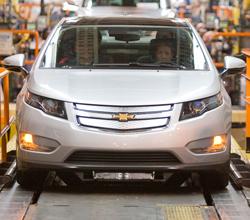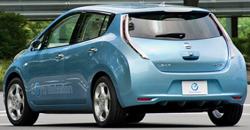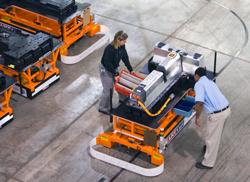Contributing editor
- FMA
- The Fabricator
- FABTECH
- Canadian Metalworking
Categories
- Additive Manufacturing
- Aluminum Welding
- Arc Welding
- Assembly and Joining
- Automation and Robotics
- Bending and Forming
- Consumables
- Cutting and Weld Prep
- Electric Vehicles
- En Español
- Finishing
- Hydroforming
- Laser Cutting
- Laser Welding
- Machining
- Manufacturing Software
- Materials Handling
- Metals/Materials
- Oxyfuel Cutting
- Plasma Cutting
- Power Tools
- Punching and Other Holemaking
- Roll Forming
- Safety
- Sawing
- Shearing
- Shop Management
- Testing and Measuring
- Tube and Pipe Fabrication
- Tube and Pipe Production
- Waterjet Cutting
Industry Directory
Webcasts
Podcasts
FAB 40
Advertise
Subscribe
Account Login
Search
Batteries power up to own the road
Fundamentals about the heart of EVs, HEVs, PHEVs
- By Kate Bachman
- April 30, 2010
- Article
- Shop Management

The first of 80 preproduction Chevy Volts rolled off the assembly line March 31. These versions are undergoing a battery of performance and safety tests preceding the full production version rollout later this year. Photo courtesy of General Motors, Detroit, by John F. Martin.
With the price of crude oil predicted to rise to prerecession levels by the end of the year, and final fuel economy rules requiring vehicle fleets to average 35.5 MPG between 2012 and 2016, the automotive industry is looking to hybrid electric and fully electric vehicles to electrify the effort to lessen or eliminate fuel emissions and to comply with the new fuel standards.
General Motors announced in January 2007 that the Chevrolet Volt® plug-in electric car would be ready for mass production and on the road by the end of 2010. The first Volts rolled off the preproduction line in March of this year (see lead image).
Nissan introduced its all-electric LEAF® earlier this year and plans to release a production version by December 2010 in select markets, with widespread availability by 2011 (see Figure 1).
At the 2009 Detroit Auto Show, Chrysler, Mercedes-Benz, Toyota, and MINI showed their concept electric vehicles. Ford, Mitsubishi, and Chrysler have announced their own hybrid and electric versions as well.
Miles per charge (MPC) may be revving up to overtake miles per gallon (MPG) as the new mileage comparison standard.
EVs, HEVs, PHEVs Mean No More Rev
Electric vehicles (EVs), also called plug-in electrics, are propelled by an electric motor that is powered by rechargeable battery packs. This replaces internal combustion engines (ICEs). The GM Volt and Nissan LEAF are examples of EVs.
Purely electric vehicles must be externally charged, or plugged into an electric outlet, to recharge the battery (see Figure 2). The Volt runs 40 miles on a charge of its 16-kilowatt-hour (kWh) lithium-ion battery pack, but is equipped with a range-extending gas generator that recharges the battery to produce enough energy to power it for up to 300 miles on a tank of gas. The Nissan LEAF is a purely electric motor vehicle, and purportedly goes considerably longer on a single charge of its 24-kWh pack, 100 miles, but has no mechanism to continue running once the battery is out of charge.
The GM EV1, produced and leased by the automaker from 1996 to 1999, was the first mass-produced EV of the modern era by a major automaker.
The early EV1's lead-acid battery technology was limited in its driving range between charges, and it lacked the durability required by the mass market. Hybrid electric vehicles were developed to counter that range limitation.
Hybrid electrics (HEVs), such as the current models of the Prius® and the Honda Insight® rely on a combination of combustion engine and electric motor for propulsion. The cars operate in a charge-sustaining mode, which means that the batteries recharge while being driven. The batteries cannot be externally charged.

Figure 1: Electric vehicles have no combustion engine, no exhaust system, and no tank; therefore, they require no gasoline and make no engine noise. Photo courtesy of Nissan USA, Franklin, Tenn.
Plug-in hybrid electrics (PHEVs), anticipated for full-scale production in 2011, are electric motor-propelled and will have batteries that can be externally charged from an off-vehicle energy source.
Although the Volt is sometimes erroneously referred to as a PHEV, it is not a hybrid because it has no combustion engine. The Volt propulsion system is powered exclusively by electricity. When its battery runs out of charge, its onboard generator uses gas to create more electricity.
Lithium-Ion Batteries Win Out
The 2009 and older-model HEVs, such as the Prius and Insight, are equipped with a nickel-metal hydride (NiMH) battery, which is a type of secondary electrochemical cell similar to the nickel-cadmium cell. The NiMH battery uses a hydrogen-absorbing alloy for the negative electrode instead of cadmium, and it can have two to three times the capacity of an equivalent-size nickel-cadmium battery. However, compared to the lithium-ion cell, the volumetric energy density is lower.
Roughly $2 billion of the American Recovery and Reinvestment Act (ARRA) was distributed for advanced battery research. Those funds were almost exclusively distributed to lithium-ion battery companies.
Lithium-ion is considered by many to be the most promising of automotive batteries because of its potential for longer ranges (see Figure 3). Lithium is the lightest of all metals, and so provides the largest energy density for weight, typically twice that of nickel-cadmium, and the greatest electrochemical potential, according to Isidor Buchmann, CEO of Cadex Electronics Inc., Vancouver, B.C., in a BatteryUniversity article.
This is the battery type currently used in laptops, PDAs, and cell phones.
Buchmann said attempts to develop rechargeable lithium batteries failed because of safety problems. Because of the inherent instability of lithium metal, especially during charging, research shifted to a nonmetallic lithium battery using lithium ions. Although slightly lower in energy density than lithium metal, lithium-ion is safe, provided certain precautions are taken when charging and discharging.
Curves Ahead for Electric-powered Vehicles, Batteries
Sticker Shock. The Volt is likely to sell for about $40,000. The LEAF is expected to sell for about $32,780. The Toyota Prius PHEV will likely be priced in the high $20,000s, but it is designed with the shortest all-electric range.
Today's hybrid electric versions, such as the Honda Civic®, are typically about $5,000 more than their combustion-engine cousins. On the other hand, the fuel savings realized may compensate for the increased cost within a few years.
The new vehicles will be eligible for federal tax credits as high as $7,500 (less for the Prius). Many states are offering attractive tax credits as well. But while soothing sticker shock for now, those incentives are designed to decrease in a few years with expectations that mass production and economies of scale will decrease costs without incentives.

Figure 2: Don't fill, charge. EV batteries are externally recharged, rather than being charged in a charge-sustaining mode while the vehicle is being driven. Photo courtesy of General Motors, Detroit, [or Nissan].
The automotive industry is keenly aware of the need to achieve near-cost parity with gasoline-combustion engine systems.
R&D leaders from GM, Nissan, PSA Peugeot Citroën, Jaguar Land Rover, Ford, and Renault met in London at the EV Battery Tech 2010 summit in March to "examine opportunities for reducing cost at every level of EV battery production." The announced goal is to reduce battery costs by 50 percent by 2020 in hopes of pricing EVs at a competitive market price.
The consortium explored EV battery technologies at every stage of production to find potential ways to reduce costs, raw materials, cell components, the battery system, and design and reduce vehicle weight.
Capacity, Range. Other challenges beyond cost for electric vehicles and their batteries include:
- Developing global standards for EV performance, safety, charging, and construction.
- Increasing capacity in terms of how much energy an EV battery can store, the range it can power, and its life cycle.
- Building charging infrastructures, such as public and home-charging stations, to extend driving ranges.
- Decreasing charging times from the current three to eight hours so they're closer to gasoline refilling times.

Figure 3: In April GM announced that it doubled the size of its Global Battery Systems Lab in Warren, Mich., to expedite the development of motive batteries to propel EVs. The batteries will be made in Brownstown Township, Mich., the first lithium-ion battery pack manufacturing plant in the U.S. operated by a major automaker. Photo courtesy of General Motors, Detroit, by Jeffrey Sauger.
About the Author

Kate Bachman
815-381-1302
Kate Bachman is a contributing editor for The FABRICATOR editor. Bachman has more than 20 years of experience as a writer and editor in the manufacturing and other industries.
subscribe now

The Fabricator is North America's leading magazine for the metal forming and fabricating industry. The magazine delivers the news, technical articles, and case histories that enable fabricators to do their jobs more efficiently. The Fabricator has served the industry since 1970.
start your free subscription- Stay connected from anywhere

Easily access valuable industry resources now with full access to the digital edition of The Fabricator.

Easily access valuable industry resources now with full access to the digital edition of The Welder.

Easily access valuable industry resources now with full access to the digital edition of The Tube and Pipe Journal.
- Podcasting
- Podcast:
- The Fabricator Podcast
- Published:
- 04/16/2024
- Running Time:
- 63:29
In this episode of The Fabricator Podcast, Caleb Chamberlain, co-founder and CEO of OSH Cut, discusses his company’s...
- Trending Articles
Steel industry reacts to Nucor’s new weekly published HRC price

How to set a press brake backgauge manually

Capturing, recording equipment inspection data for FMEA

Are two heads better than one in fiber laser cutting?

Hypertherm Associates implements Rapyuta Robotics AMRs in warehouse

- Industry Events
16th Annual Safety Conference
- April 30 - May 1, 2024
- Elgin,
Pipe and Tube Conference
- May 21 - 22, 2024
- Omaha, NE
World-Class Roll Forming Workshop
- June 5 - 6, 2024
- Louisville, KY
Advanced Laser Application Workshop
- June 25 - 27, 2024
- Novi, MI


























